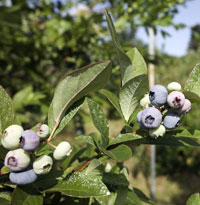|
NWEA Seeks Pesticide Streamside Buffer Zone;
Petition Includes SWD Zapper
A petition proposing riparian no-spray buffer zones involving a number of chemicals used by farmers will, if adopted, impact how blueberry growers protect their streamside crops against various pests, especially the one they fear most.
 The petition, presented to Oregon’s Environmental Quality Commission (EQC) by Northwest Environmental Advocates (NWEA), is asking that agency to ban a list of pesticides within varying prescribed boundaries of salmon-bearing waterways. The petition, presented to Oregon’s Environmental Quality Commission (EQC) by Northwest Environmental Advocates (NWEA), is asking that agency to ban a list of pesticides within varying prescribed boundaries of salmon-bearing waterways.
“Research shows that that’s probably any waterway in the Willamette Valley, probably even including (high-flow) drainage ditches in some places,” said Roger Beyer, lobbyist for the Oregon Blueberry Commission.
Beyer, who testified at a public hearing held by EQC and also submitted his written views, said that based on the hearing and comment period, a decision will be made on the matter in late October.
Of the fourteen stakeholders who testified at the hearing, he is believed to be the only one who represented the blueberry industry. Beyer also testified on behalf of three other clients of his, the Oregon Small Woodlands Association, the Oregon Dairy Farmers Association and the Oregon Seed Council.
Thirteen of the 14 testifiers were opposed to the buffer zone, Beyer noted.
Beyer said that several years ago a number of environmental advocate groups filed a lawsuit in Washington similar to the one NWEA filed with EQC. While they won that case it has been in appeal ever since, Beyer said.
As a result of the Washington case, the U.S. Fish & Wildlife Service and National Marine Fisheries Service (NMFS) formulated biological opinions on how to protect salmon waterways from close to 30 chemicals, Beyer said. He added that because EPA hasn’t acted on the matter, NWEA is now asking Oregon EQC to implement those pesticide buffer rules in Oregon.
Because the Washington case is still being litigated, Beyer said that agricultural and forestry stakeholders in Oregon and Washington feel it is “completely inappropriate for EQC to implement something that’s still being litigated and not going anywhere else in the nation.”
Whether there was potential for the case to be settled by eliminating only certain of the 27 chemicals, or if an all-or-none situation exists, Beyer said he couldn’t say for sure. “If EQC was to grant the commission, they would have to go into rule-making, and they could do just about anything (then).”
Aerial- and ground-application restrictions for chemicals on the list vary. In some cases, such as the restriction of 2,4-D use on any riparian “vegetation,” the meaning is vague.
Of all the pesticides on the threatened list, malathion, the only protection blueberry growers have against spotted wing Drosophila, looms large. “There would be a 1,000-foot aerial buffer and a 500-foot ground application buffer for that chemical,” Beyer said.
In a September 17 letter to EQC chair Bill Blosser, Beyer said that the pesticide biological opinions submitted in support of the petition were not based on peer reviewed scientific data and that the buffer would put Oregon ag producers at a “distinct disadvantage” with those in other states.
Following is a list of the pesticides involved:
Chlorpyrifos, diazinon and malathion – 1,000 foot aerial and 500 foot ground application buffers.
(Trade names: Dursban, Empire, Equity, Govern, Hatchet, Lentrek, Lock-On, Lorsban, Diacap, Fezudin, Neocidin, Neocidol B40, Basudin, Neocidol, Sarolex, Malixol, Joseol, Malathane, Malathyne.)
Carbaryl and carbofuran – 1,000 foot aerial and up to 600 foot ground application buffers.
(Trade Names: Sevimol, Sevin, Carbex, Carbar, Fudan, Chinufur, Furamate, Futura.)
Methomyl – 600 foot aerial and 50 foot ground application buffers.
(Trade Names: Lannate, Metosip, Mieduocare, Kilon, Sunthomyl.)
Bensulide, dimethoate, ethoprop, methidathion, naled, phorate and phosmet - yet to be determined buffers.
(Trade Names: Betasan, Prefar, Bi 58, Perfekthion, Rebelate, Roxion, Aniron, Dimesun, Dimexo, Stinger, Sunagor, Chipco, Mocap, Supracide, Ultracid, Ultracide, Dibrom, Trumpet, Thimet Lock'n Load, Thimet, SmartBox, Fosdan, Imidan.)
2,4-D, diuron and chlorothalonil – no application to riparian vegetation is allowed.
(Trade Names: Amoxone, Chloroxone, Crop Rider, Dinoxol, Dormone, Emulsamine, Fernimine*, Fernoxone, Gesapax-H, Rilof-H, Base Camp Amine 4, Weco Max, Brash, E-99, Phenoxy 088, Strike 3, Strike Three Ultra 2, SWB 2,4-D, Duplosan, Dyvel DS, Lotus D, Topshot, U 46 Combi-Fluid, U 46 D-Fluid, U 46 KV-Combi-Fluid, Weedmaster, Anduron, Durashield, Crisuron, Crystal Diuron, Bravo, Bravonil, Chloronil, Countdown, Daconil , Ole, Tuff Brite, Tuffcide.)
Pendimethalin and trifluralin – 300 foot aerial and 20 foot ground application buffers or vegetative strip.
(Trade Names: Accotab, Go-Go-San, Herbadox, Hurdle, Pendulum, Prowl, Repose, Sipaxol, Stomp, Way Up, Pendimax, Bayonet, Passport, Super T, Tri-4, Tri-Scept.)
Oryzalin – 20 foot ground application buffers or vegetative strip.
(Trade Names: Surf, Surlfan.)
Propargite, Fenbutatin-oxide, diflubenzuron, 1, 3-D, lindane, racemic metolachlor, bromoxynil and prometryn – Currently in the BiOp process.
|
Message from the Chairman
Smooth Move Into South Korea
Market Update -
The Oregon "Bluescape" Just Keeps Getting Greener
Oregon Blueberry Promotions Busy Last Summer
NWEA Seeks Pesticide Streamside Buffer Zone
USDOL Actions Leave Heavy Fines, Angry Growers in Wake
Organic Blueberry Production Systems Research Highlights and Future Plans
Some Do's and Don'ts of Drip Irrigation
Make Plans for 2013 Blueberry Conference
Food Safety Classes to Expand in 2013
|

 The petition, presented to Oregon’s Environmental Quality Commission (EQC) by Northwest Environmental Advocates (NWEA), is asking that agency to ban a list of pesticides within varying prescribed boundaries of salmon-bearing waterways.
The petition, presented to Oregon’s Environmental Quality Commission (EQC) by Northwest Environmental Advocates (NWEA), is asking that agency to ban a list of pesticides within varying prescribed boundaries of salmon-bearing waterways.